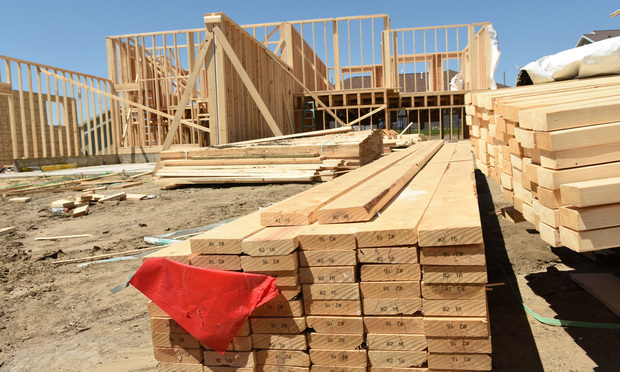How to Cope With Construction Industry Labor Shortages
The United States is on the precipice of a massive skilled labor shortage, according to the 2017 Commercial Construction Index. Compiled by USG Corporation and the U.S. Chamber of Commerce, the survey revealed “steady optimism from contractors about revenue forecasts and their backlog of work, yet concerns about the availability, training and cost” of hiring skilled workers in 2018.
January 29, 2018 at 04:14 PM
7 minute read

The United States is on the precipice of a massive skilled labor shortage, according to the 2017 Commercial Construction Index. Compiled by USG Corp. and the U.S. Chamber of Commerce, the survey revealed “steady optimism from contractors about revenue forecasts and their backlog of work, yet concerns about the availability, training and cost” of hiring skilled workers in 2018. Beginning in the latter half of 2017, the shortage could be the largest our country has seen in decades, with the potential to weaken a sector that currently contributes more than $700 billion to the U.S. economy.
On a positive front, this shortage also indicates demand for commercial construction projects is currently very high, with aggressive building programs beginning throughout the year across the country. In the short term, companies have started to offer increased wages, more benefits, additional overtime opportunities and are even sourcing support from neighboring regions to meet this demand. However, adequate long-term planning still is required to fulfill the contractual obligations of upcoming projects.
The article examines several causes for the impending construction labor shortage and provides advice to help educate and protect those in the construction industry as they embark on new projects in the coming months.
Why the Shortage?
A number of contributing factors have created the perfect storm for a labor shortage. The 2008 recession likely started the shift, when thousands of construction workers lost their jobs because of the failing economy. Some of these individuals either changed careers or never reentered the workforce once the economy bounced back. Notably, a significant number of Baby Boomers opted to retire.
In addition, societal and population changes often can be linked to labor shortages. For example, surveys are showing that younger generations are less interested in acquiring skilled labor positions than previous generations, thus causing a large age gap in the current workforce. Moreover, many school districts have not actively promoted vocational training, so fewer students over the years have pursued this career path. Additionally, changes in immigration have reduced the numbers of immigrant workers available for certain jobs.
Advances in a number of industries, unforeseen development/redevelopment in certain areas of the country and major expansions in infrastructure have caused an increase in the number of new commercial projects as well. The technology and healthcare sectors, for instance, have experienced significant growth over the years. And, increased demand in various “hot spot” regions have caused a workforce migration. By way of example, hurricane relief efforts have drawn many workers to those areas hardest hit. Many 2017 rebuilding projects are still underway in some of these locations, thus creating an unpredictable need for workers there and leaving shortages elsewhere. According to a recent article in The Wall Street Journal, commercial projects in big cities like Los Angeles, Chicago, New York, Boston and Miami also have contributed to the labor shortage.
Tips for Industry Professionals
One trend we are seeing, specifically in Pennsylvania, is that contractors have sourced talent from neighboring counties and states to fill labor demands on various jobs. As these projects begin to wind down, and as construction opportunities closer to home for these out-of-market workers arise, these skilled workers may return to their hometowns. Beginning in 2018, contractors likely will start to feel the constraints of a smaller available workforce.
What does this mean for the foreseeable future? Owners and contractors should take extra care when aligning labor with projects—and that starts during contract negotiations:
- Carefully review adequate labor provisions: From a contractual standpoint, most agreements will indicate that the general contractor (GC) is responsible for providing adequate labor to execute the work outlined. How is this labor shortage going to affect those provisions? Can the GC meet the deadlines outlined if you know there is an upcoming labor shortage? How important are the deadlines to the owner?
- Check for milestone dates: Sometimes, contracts will have provisions that use project milestones to govern payment terms. For instance, a project beginning in January may be scheduled for final completion in August. However, the owner may require 50 percent of the work to be completed by May in order for the GC to be compensated for 50 percent of the job. As an owner or GC, you need to know if you are going to have enough labor to support project milestones before entering into the agreement.
- Review language surrounding project timing, delays as it relates to labor: Based upon the contract language, if the GC cannot complete the project on time due to labor shortages, is that delay going to be attributable to the GC, or is that something that is viewed as an uncontrollable market condition that all parties will have to deal with? Does the fact that a labor shortage appears imminent change how these contract terms may later be viewed and interpreted? All of these questions need be addressed up front and clearly reflected in the contract language to avoid potential liabilities down the road.
- Pay attention to liquidated damages: Frequently, for projects that require a hard, specific completion date based upon the business of their owners (such as schools, restaurants or retail establishments), owners will include contract provisions outlining liquidated damages that could be enforced for failure to meet project deadlines. These are primarily included as financial protections for the owner, ensuring it will be compensated should the project not reach completion on time. In reviewing these provisions, owners and GCs should take time to determine a game plan for dealing with possible labor issues that could impact the project schedule and threaten timely completion of the work.
- Be proactive: Can you plan ahead so that you have additional laborers on site as needed? What about pricing—could a favorable compensation structure be an option to incentivize all parties to avoid project delays at all costs? What about insurance coverage to protect your company in the event that all other safeguards fail? Not all of these will be viable solutions for every situation, but searching for strategic options at the outset of a project is the best way to guard against potential problems in the future.
According to Anirban Basu, chief economist of the Associated Builders and Contractors, labor costs in the construction industry are rising an average of 4 to 5 percent annually, and those figures will only continue to grow as the need for skilled workers increases. Bottom line— his is going to be a significant issue as companies dive deeper into 2018 projects, and if the industry isn't prepared, there could be greater implications down the line.
Above all, owners and GCs alike should take note of this economic shift and be open and honest with each other during the initial project and contract development phase. Be sure to carefully scope all timelines, budgets and staffing schedules to avoid surprises once work begins. And, as always, taking time to have contracts reviewed by a qualified legal team who knows your business is the best way to ensure that all available options have been explored.
Joshua Lorenz is an attorney at Pittsburgh-based law firm Meyer, Unkovic & Scott. He focuses his practice on construction law and litigation. Joshua can be reached at [email protected]
This content has been archived. It is available through our partners, LexisNexis® and Bloomberg Law.
To view this content, please continue to their sites.
Not a Lexis Subscriber?
Subscribe Now
Not a Bloomberg Law Subscriber?
Subscribe Now
NOT FOR REPRINT
© 2025 ALM Global, LLC, All Rights Reserved. Request academic re-use from www.copyright.com. All other uses, submit a request to [email protected]. For more information visit Asset & Logo Licensing.
You Might Like
View All
AI and Social Media Fakes: Are You Protecting Your Brand?

Neighboring States Have Either Passed or Proposed Climate Superfund Laws—Is Pennsylvania Next?
7 minute read
Seven Rules of the Road for Managing Referrals To/From Other Attorneys, Part 2
6 minute readTrending Stories
- 1We the People?
- 2New York-Based Skadden Team Joins White & Case Group in Mexico City for Citigroup Demerger
- 3No Two Wildfires Alike: Lawyers Take Different Legal Strategies in California
- 4Poop-Themed Dog Toy OK as Parody, but Still Tarnished Jack Daniel’s Brand, Court Says
- 5Meet the New President of NY's Association of Trial Court Jurists
Who Got The Work
J. Brugh Lower of Gibbons has entered an appearance for industrial equipment supplier Devco Corporation in a pending trademark infringement lawsuit. The suit, accusing the defendant of selling knock-off Graco products, was filed Dec. 18 in New Jersey District Court by Rivkin Radler on behalf of Graco Inc. and Graco Minnesota. The case, assigned to U.S. District Judge Zahid N. Quraishi, is 3:24-cv-11294, Graco Inc. et al v. Devco Corporation.
Who Got The Work
Rebecca Maller-Stein and Kent A. Yalowitz of Arnold & Porter Kaye Scholer have entered their appearances for Hanaco Venture Capital and its executives, Lior Prosor and David Frankel, in a pending securities lawsuit. The action, filed on Dec. 24 in New York Southern District Court by Zell, Aron & Co. on behalf of Goldeneye Advisors, accuses the defendants of negligently and fraudulently managing the plaintiff's $1 million investment. The case, assigned to U.S. District Judge Vernon S. Broderick, is 1:24-cv-09918, Goldeneye Advisors, LLC v. Hanaco Venture Capital, Ltd. et al.
Who Got The Work
Attorneys from A&O Shearman has stepped in as defense counsel for Toronto-Dominion Bank and other defendants in a pending securities class action. The suit, filed Dec. 11 in New York Southern District Court by Bleichmar Fonti & Auld, accuses the defendants of concealing the bank's 'pervasive' deficiencies in regards to its compliance with the Bank Secrecy Act and the quality of its anti-money laundering controls. The case, assigned to U.S. District Judge Arun Subramanian, is 1:24-cv-09445, Gonzalez v. The Toronto-Dominion Bank et al.
Who Got The Work
Crown Castle International, a Pennsylvania company providing shared communications infrastructure, has turned to Luke D. Wolf of Gordon Rees Scully Mansukhani to fend off a pending breach-of-contract lawsuit. The court action, filed Nov. 25 in Michigan Eastern District Court by Hooper Hathaway PC on behalf of The Town Residences LLC, accuses Crown Castle of failing to transfer approximately $30,000 in utility payments from T-Mobile in breach of a roof-top lease and assignment agreement. The case, assigned to U.S. District Judge Susan K. Declercq, is 2:24-cv-13131, The Town Residences LLC v. T-Mobile US, Inc. et al.
Who Got The Work
Wilfred P. Coronato and Daniel M. Schwartz of McCarter & English have stepped in as defense counsel to Electrolux Home Products Inc. in a pending product liability lawsuit. The court action, filed Nov. 26 in New York Eastern District Court by Poulos Lopiccolo PC and Nagel Rice LLP on behalf of David Stern, alleges that the defendant's refrigerators’ drawers and shelving repeatedly break and fall apart within months after purchase. The case, assigned to U.S. District Judge Joan M. Azrack, is 2:24-cv-08204, Stern v. Electrolux Home Products, Inc.
Featured Firms
Law Offices of Gary Martin Hays & Associates, P.C.
(470) 294-1674
Law Offices of Mark E. Salomone
(857) 444-6468
Smith & Hassler
(713) 739-1250






